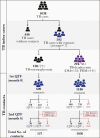The Effect of Diabetes and Prediabetes on Mycobacterium tuberculosis Transmission to Close Contacts
- PMID: 34008010
- PMCID: PMC8672762
- DOI: 10.1093/infdis/jiab264
The Effect of Diabetes and Prediabetes on Mycobacterium tuberculosis Transmission to Close Contacts
Abstract
Background: It is unknown whether dysglycemia is associated with Mycobacterium tuberculosis transmission.
Methods: We assessed epidemiological and clinical characteristics of patients with culture-confirmed pulmonary tuberculosis and their close contacts, enrolled in a multicenter prospective cohort in Brazil. Contacts were investigated at baseline and 6 months after enrollment. QuantiFERON positivity at baseline and conversion (from negative to positive at month 6) were compared between subgroups of contacts according to glycemic status of persons with tuberculosis (PWTB) as diabetes mellitus (DM) or prediabetes. Multivariable mixed-effects logistic regression models were performed to test independent associations with baseline QuantiFERON positive and QuantiFERON conversion.
Results: There were 592 PWTB (153 DM, 141 prediabetes, 211 normoglycemic) and 1784 contacts, of whom 658 were QuantiFERON-positive at baseline and 106 converters. Multivariable analyses demonstrated that tuberculosis-prediabetes cases, acid-fast bacilli-positive, pulmonary cavities, and living with someone who smoked were independently associated with QuantiFERON positive in contacts at baseline. DM, persistent cough, acid-fast bacilli-positive, and pulmonary cavities in tuberculosis source cases were associated with QuantiFERON conversion.
Conclusions: Contacts of persons with pulmonary tuberculosis and dysglycemia were at increased risk of being QuantiFERON positive at baseline or month 6. Increased focus on such close contacts could improve tuberculosis control.
Keywords: Mycobacterium tuberculosis; diabetes; interferon-γ releasing assay; prediabetes; quantiFERON.
© The Author(s) 2021. Published by Oxford University Press for the Infectious Diseases Society of America. All rights reserved. For permissions, e-mail: journals.permissions@oup.com.
Figures




References
-
- Lönnroth K, Jaramillo E, Williams BG, Dye C, Raviglione M. Drivers of tuberculosis epidemics: the role of risk factors and social determinants. Soc Sci Med 2009; 68:2240–6. - PubMed
-
- Pizzol D, Di Gennaro F, Chhaganlal KD, et al. Tuberculosis and diabetes: current state and future perspectives. Trop Med Int Health 2016; 21:694–702. - PubMed
Publication types
MeSH terms
Substances
Grants and funding
LinkOut - more resources
Full Text Sources
Other Literature Sources
Medical

